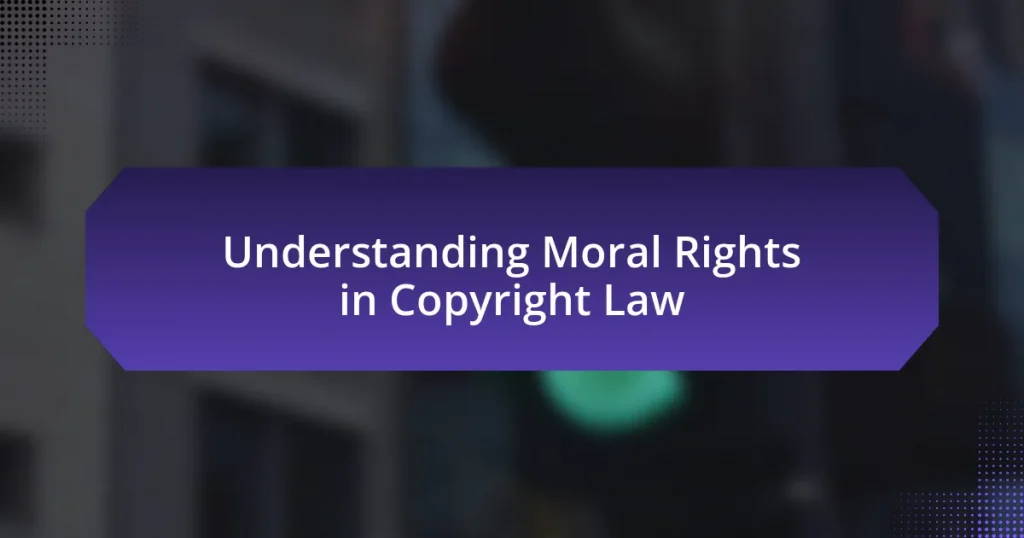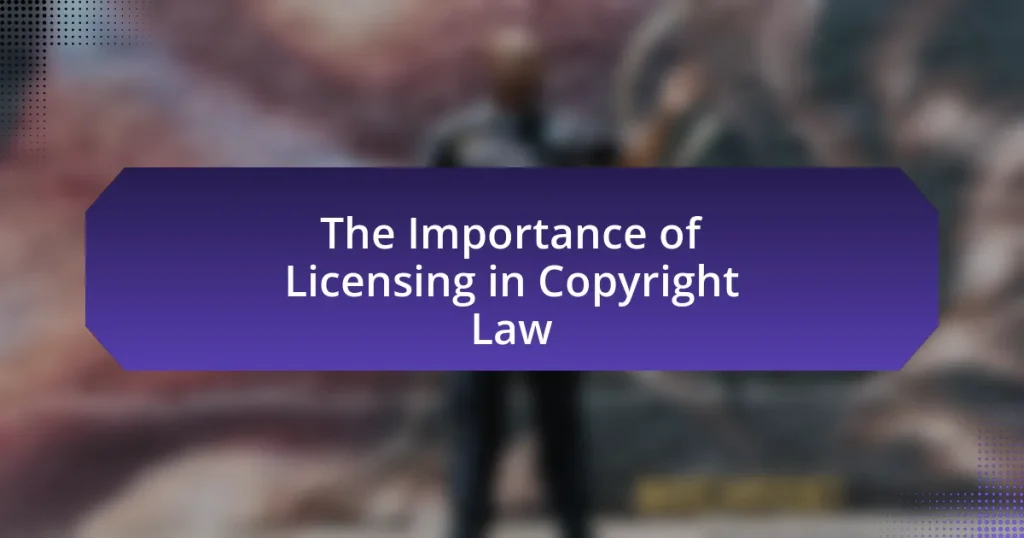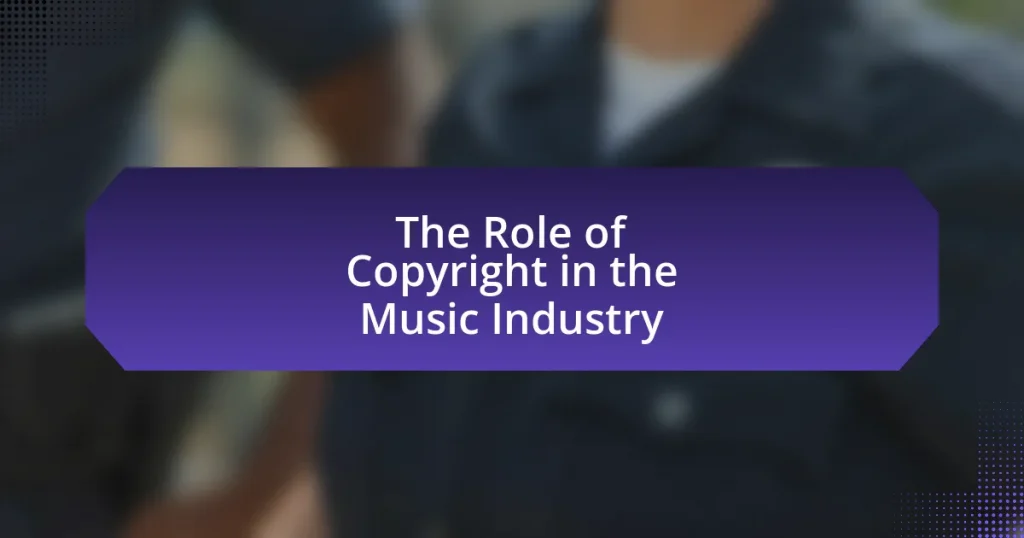Copyright law in the fashion industry serves to protect original designs, patterns, and artistic works from unauthorized use, allowing designers to claim ownership over their creations. The article examines how copyright law applies specifically to fashion design, detailing the types of creations that can be copyrighted and the legal protections available to designers. It highlights the unique challenges faced by the fashion industry, including the limitations of copyright in covering functional aspects of clothing, the impact of fast fashion, and the complications introduced by digital media and social platforms. Additionally, the article discusses best practices for designers to navigate copyright law effectively, including documentation of their creative process and strategies for avoiding infringement.
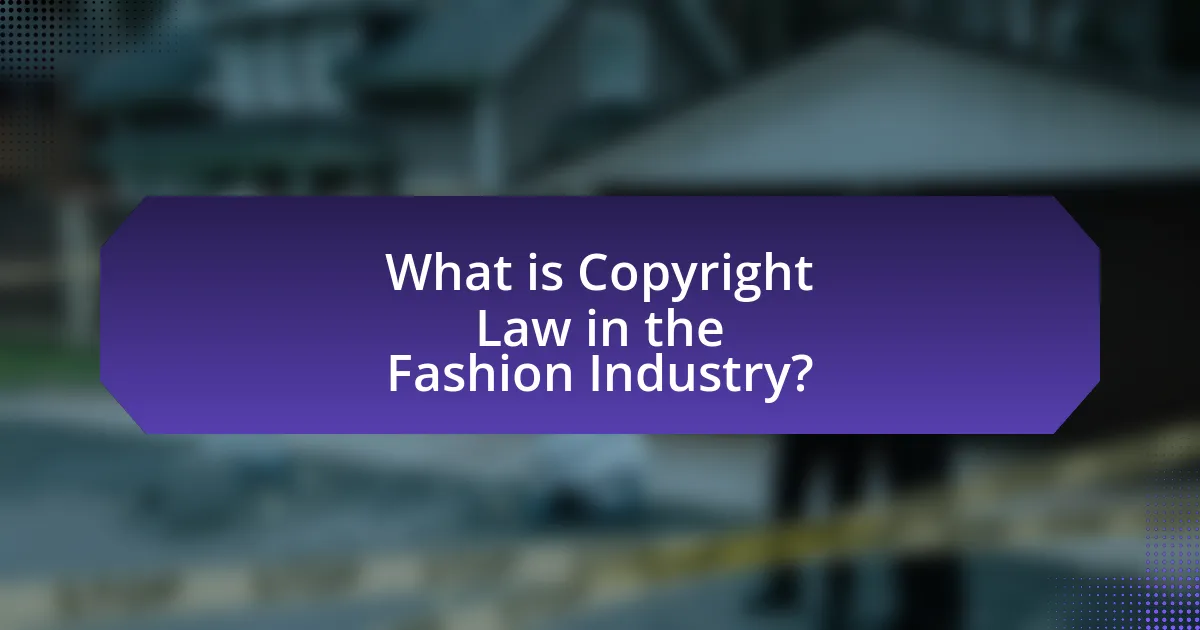
What is Copyright Law in the Fashion Industry?
Copyright law in the fashion industry protects original designs, patterns, and artistic works from unauthorized use. This legal framework allows designers to claim ownership over their creations, preventing others from copying or reproducing them without permission. In the United States, for example, the Copyright Act of 1976 grants protection to “original works of authorship,” which includes fashion designs that exhibit creativity and originality. However, the law faces challenges in the fashion sector, as it does not cover functional aspects of clothing, leading to ongoing debates about the extent of protection available for fashion items.
How does copyright law apply specifically to fashion design?
Copyright law applies to fashion design by protecting original works of authorship, including the artistic aspects of clothing and accessories. This means that designers can claim exclusive rights to their unique designs, preventing others from copying or reproducing them without permission. However, copyright does not extend to functional aspects or utilitarian features of clothing, which limits the scope of protection. For instance, the U.S. Copyright Office recognizes that while a specific pattern or graphic on a garment can be copyrighted, the overall shape or style of the garment itself typically cannot be. This distinction highlights the unique challenges in the fashion industry, where the line between artistic expression and functional design often blurs.
What types of fashion creations can be copyrighted?
Fashion creations that can be copyrighted include original designs, patterns, and textile prints that exhibit a minimum level of creativity and originality. Copyright protection applies to the specific expression of ideas in fashion, such as the unique arrangement of colors, shapes, and materials in a garment. For instance, a distinctive dress design or a unique fabric pattern can be copyrighted, as long as it is not purely functional or a common design. This is supported by the U.S. Copyright Office, which states that copyright does not protect ideas, concepts, or methods of operation, but rather the tangible expression of those ideas.
How does copyright law protect fashion designers’ works?
Copyright law protects fashion designers’ works by granting them exclusive rights to reproduce, distribute, and display their original designs. This legal framework allows designers to control how their creations are used and prevents unauthorized copying or imitation. For instance, under the U.S. Copyright Act, fashion designs can be protected if they meet the criteria of originality and fixation, meaning the design must be sufficiently unique and expressed in a tangible medium. Additionally, landmark cases, such as the 2018 decision in the case of “Star Athletica, LLC v. Varsity Brands, Inc.,” established that certain aspects of fashion designs, like surface designs on clothing, can be copyrighted, reinforcing the protection available to designers.
Why is copyright law important for fashion brands?
Copyright law is important for fashion brands because it protects their original designs and creative expressions from unauthorized use. This legal protection allows fashion brands to maintain their unique identity and competitive edge in a highly saturated market. For instance, the U.S. Copyright Office recognizes that fashion designs can be copyrighted if they contain sufficient originality, which helps prevent imitation and counterfeiting. By safeguarding their intellectual property, fashion brands can secure their investments in design and innovation, ultimately fostering a more vibrant and diverse fashion industry.
What risks do fashion brands face without copyright protection?
Fashion brands without copyright protection face significant risks, including increased vulnerability to counterfeiting and imitation. Without legal safeguards, competitors can easily replicate designs, leading to brand dilution and loss of market share. According to a report by the International Trademark Association, counterfeiting costs the global economy over $500 billion annually, highlighting the financial impact on brands lacking protection. Additionally, the absence of copyright can result in legal disputes, as brands may struggle to prove ownership of their designs, further complicating their ability to enforce rights. This lack of protection undermines innovation and investment in original creations, ultimately threatening the sustainability of fashion brands in a competitive market.
How does copyright law impact brand reputation and value?
Copyright law significantly impacts brand reputation and value by protecting original works and preventing unauthorized use, which helps maintain a brand’s unique identity. When brands effectively enforce their copyright, they reinforce their market position and consumer trust, as seen in cases like Louis Vuitton, which has successfully litigated against counterfeiters to uphold its brand integrity. Conversely, failure to protect copyrighted material can lead to diminished brand value and reputation, as consumers may associate the brand with lower quality or lack of originality. This correlation is evident in the fashion industry, where brands that actively engage in copyright enforcement often enjoy higher consumer loyalty and market share.
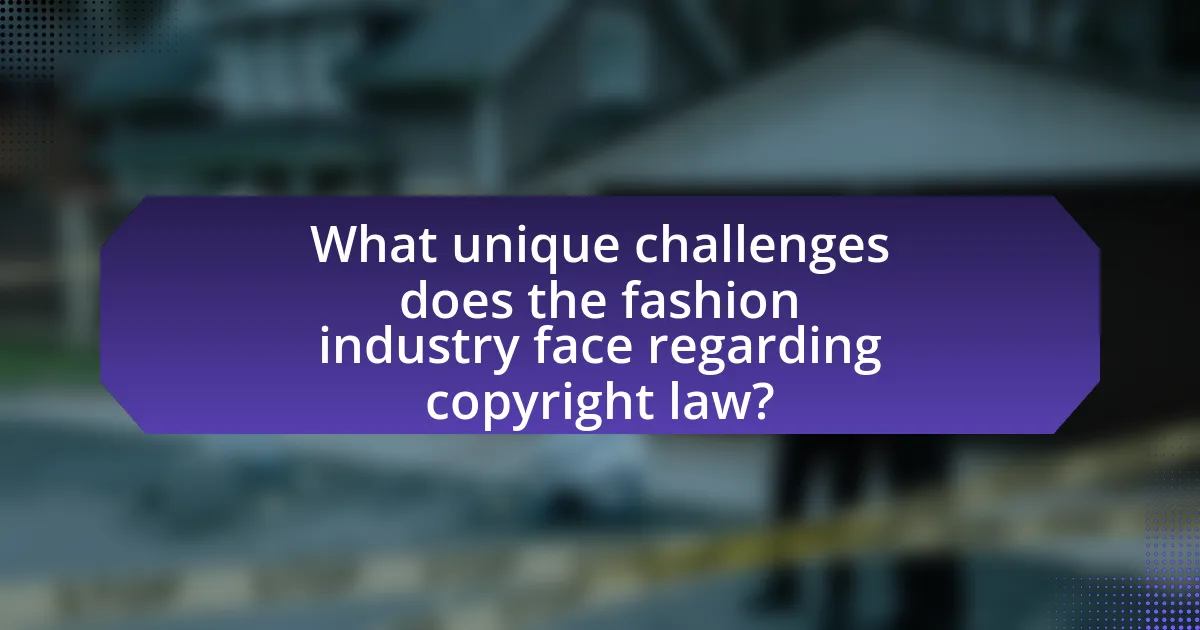
What unique challenges does the fashion industry face regarding copyright law?
The fashion industry faces unique challenges regarding copyright law primarily due to the difficulty in protecting designs that are often considered functional or utilitarian. Unlike other creative fields, fashion designs can be quickly replicated, leading to widespread infringement. For instance, the U.S. Copyright Office does not recognize fashion designs as copyrightable unless they contain a significant artistic element, which complicates legal protection. Additionally, the fast-paced nature of fashion trends means that by the time legal action is taken, the original design may already be out of style, rendering enforcement ineffective. This situation is exacerbated by the global nature of the fashion market, where differing copyright laws across countries create inconsistencies in protection and enforcement.
How does fast fashion complicate copyright enforcement?
Fast fashion complicates copyright enforcement by rapidly producing and distributing designs that often closely mimic or directly copy original works, making it difficult for designers to protect their intellectual property. The quick turnaround time in fast fashion allows brands to capitalize on trends before original creators can assert their rights, leading to a dilution of copyright protections. For instance, a study by the European Union Intellectual Property Office found that 20% of fashion items sold in fast fashion stores infringe on existing copyrights, highlighting the scale of the issue. This environment creates challenges for enforcement, as legal processes can be slow and costly, often dissuading designers from pursuing claims against larger fast fashion retailers.
What are the implications of rapid production cycles on copyright?
Rapid production cycles significantly complicate copyright enforcement in the fashion industry. The fast-paced nature of design and production leads to an increase in the frequency of potential copyright infringements, as new designs are created and released before existing protections can be established. For instance, the fashion industry often sees trends emerge and fade within weeks, making it challenging for designers to secure copyright registrations in time to protect their work. Additionally, the ease of copying designs in a digital age exacerbates the issue, as competitors can quickly replicate popular styles without facing immediate legal repercussions. This situation creates a landscape where original creators struggle to defend their intellectual property rights effectively, leading to a potential devaluation of unique designs and innovation within the industry.
How do consumer trends affect copyright challenges in fashion?
Consumer trends significantly influence copyright challenges in fashion by increasing the demand for rapid design replication and innovation. As consumers seek fast fashion and unique styles, brands often face difficulties in protecting their original designs from imitation, leading to a rise in copyright infringement cases. For instance, the popularity of social media platforms accelerates the spread of trends, prompting brands to quickly adapt their offerings, which can blur the lines of originality and copyright protection. This dynamic environment necessitates a reevaluation of existing copyright laws to address the fast-paced nature of consumer demand and the resultant challenges in enforcing intellectual property rights effectively.
What role does digital media play in copyright issues for fashion?
Digital media significantly complicates copyright issues in the fashion industry by facilitating the rapid dissemination and reproduction of designs. The ease of sharing images and content online increases the risk of unauthorized use, leading to potential infringement cases. For instance, a study by the Fashion Law Institute highlights that over 80% of fashion designers have experienced their work being copied online without permission. This widespread sharing creates challenges in enforcing copyright protections, as traditional legal frameworks struggle to keep pace with the speed and scale of digital media.
How has social media changed the landscape of copyright in fashion?
Social media has significantly altered the landscape of copyright in fashion by facilitating rapid dissemination and imitation of designs. Platforms like Instagram and Pinterest enable users to share images of fashion items instantly, leading to increased exposure but also to unauthorized copying of original designs. A study by the Fashion Law Institute highlights that the ease of sharing on social media has made it challenging for designers to protect their intellectual property, as designs can go viral before legal protections can be enforced. This shift has prompted fashion brands to adapt their strategies, focusing on brand identity and consumer engagement rather than solely on traditional copyright enforcement.
What are the challenges of protecting designs in an online marketplace?
The challenges of protecting designs in an online marketplace include the ease of copying and distributing designs, the difficulty in enforcing intellectual property rights, and the lack of uniform regulations across different jurisdictions. Online platforms facilitate rapid replication of designs, making it hard for original creators to monitor and combat infringement. Additionally, the global nature of online marketplaces complicates legal enforcement, as laws vary significantly by country, leading to inconsistent protection. According to a report by the World Intellectual Property Organization, over 80% of fashion designers have experienced design theft, highlighting the pervasive issue of infringement in the digital space.
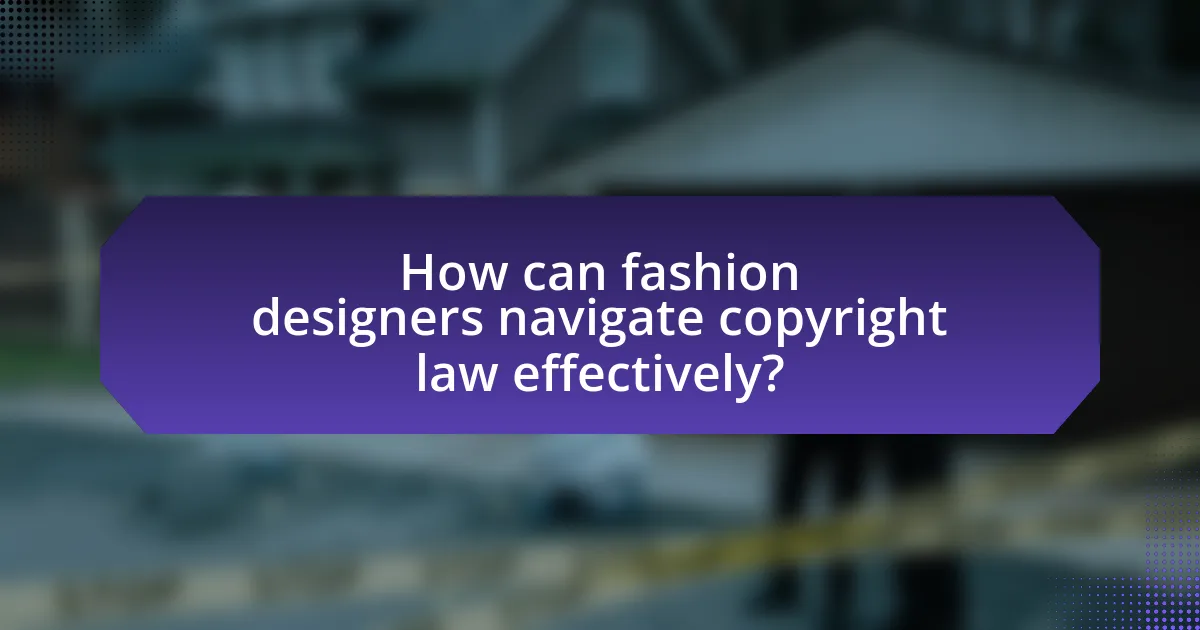
How can fashion designers navigate copyright law effectively?
Fashion designers can navigate copyright law effectively by understanding the scope of copyright protection, which covers original works of authorship, including fashion designs that are sufficiently unique. Designers should document their creative process, maintain records of their designs, and consider registering their works with the U.S. Copyright Office to enhance legal protection. Additionally, they should stay informed about relevant case law and industry standards, as these can influence the interpretation of copyright in fashion. For instance, the case of “Rogers v. Koons” illustrates how courts assess originality and fair use in artistic works, providing a framework for designers to understand their rights and limitations.
What best practices should fashion designers follow for copyright protection?
Fashion designers should register their designs with the U.S. Copyright Office to ensure legal protection against unauthorized use. This formal registration provides a public record of ownership and is necessary for pursuing legal action in case of infringement. Additionally, designers should maintain detailed documentation of their design process, including sketches, photographs, and notes, to establish originality and the timeline of creation. Implementing non-disclosure agreements (NDAs) with collaborators and manufacturers can further safeguard designs from being disclosed or copied. Regularly monitoring the market for potential infringements and being proactive in enforcing rights can also help protect intellectual property effectively.
How can designers document their creative process for copyright claims?
Designers can document their creative process for copyright claims by maintaining detailed records of their work, including sketches, drafts, and notes that chronicle the evolution of their designs. This documentation should include timestamps, which can be established through dated files or digital timestamps, to provide evidence of the timeline of creation. Additionally, designers should consider using a combination of physical and digital portfolios that showcase the progression of their ideas, as well as any research or inspiration that influenced their work. This method is supported by the U.S. Copyright Office, which emphasizes the importance of evidence in establishing ownership and originality in copyright claims.
What resources are available for understanding copyright law in fashion?
Resources available for understanding copyright law in fashion include legal textbooks, online courses, and industry-specific guidelines. Legal textbooks such as “Copyright Law in a Nutshell” by Arthur R. Miller provide foundational knowledge, while online platforms like Coursera and edX offer courses specifically focused on intellectual property in fashion. Additionally, organizations like the Fashion Law Institute provide resources and publications that address the unique challenges of copyright in the fashion industry, including case studies and legal analyses. These resources collectively enhance comprehension of copyright law as it pertains to fashion design and branding.
What common pitfalls should designers avoid regarding copyright?
Designers should avoid the pitfall of assuming that inspiration does not infringe on copyright. Many designers mistakenly believe that drawing inspiration from existing works is permissible, but copyright law protects original expressions of ideas, not just the ideas themselves. For instance, the case of “Rogers v. Koons” illustrates that even transformative works can be subject to copyright claims if they closely resemble the original. Additionally, designers should refrain from using stock images or third-party content without proper licensing, as unauthorized use can lead to legal repercussions. The importance of obtaining explicit permission or licenses for any borrowed elements is underscored by numerous copyright infringement cases in the fashion industry, which highlight the necessity of respecting intellectual property rights.
How can designers ensure they are not infringing on others’ copyrights?
Designers can ensure they are not infringing on others’ copyrights by conducting thorough research on existing works and obtaining necessary licenses or permissions. This involves reviewing databases, such as the U.S. Copyright Office, to identify copyrighted materials and understanding the scope of copyright law, which protects original works of authorship. Additionally, designers should create original designs that do not closely resemble existing copyrighted works, as the “substantial similarity” standard can lead to legal disputes. Legal precedents, such as the case of “Rogers v. Koons,” illustrate the importance of originality and the risks of copying. By adhering to these practices, designers can minimize the risk of copyright infringement.
What steps should be taken if a copyright infringement occurs?
If a copyright infringement occurs, the first step is to document the infringement by collecting evidence such as screenshots, URLs, and any relevant communications. This documentation serves as proof of the infringement. Next, the copyright owner should send a cease-and-desist letter to the infringer, formally requesting them to stop the infringing activity. If the infringer does not comply, the copyright owner may consider filing a Digital Millennium Copyright Act (DMCA) takedown notice if the infringement is online. Additionally, pursuing legal action in court may be necessary to seek damages or an injunction against further infringement. These steps are crucial as they provide a structured approach to addressing copyright violations effectively.

